Question
Please answer the following OS161 basic question. There are 13 questions, please make sure you answer all of them otherwise I will mark incomplete and
Please answer the following OS161 basic question. There are 13 questions, please make sure you answer all of them otherwise I will mark incomplete and report you, Thanks!!!!
The Kern Subdirectory
Once again, there is a Makefile. This Makefile installs header files but does not build anything.
In addition, we have more subdirectories for each component of the kernel as well as some utility directories. kern/arch: This is where architecture-specific code goes. By architecture-specific, we mean the code that differs depending on the hardware platform on which you're running.
For our purposes, you need only concern yourself with the mips subdirectory.
kern/arch/mips/conf:
conf.arch: This tells the kernel config script where to find the machine-specific, low-level functions it needs (see kern/arch/mips/mips).
Makefile.mips: Kernel Makefile; this is copied when you "config a kernel".
kern/arch/mips/include: These files are include files for the machine-specific constants and functions.
Question 1.Which register number is used for the frame pointer (fp) in OS/161?
Question 2.OS/161 supports LAMEbus. What is its base address?
Question 3.What is SPLHIGH and what is curspl?
Question 4.What is the size of a VM page in OS/161?
kern/arch/mips/mips: These are the source files containing the machine-dependent code that the kernel needs to run. Most of this code is quite low-level.
Question 5.What does splx take as input?
Question 6.Which register is used for interrupt priority masking in OS/161?
kern/asst0: This is the directory that contains the framework code that you will need to complete assignment 2. You can safely ignore it for now.
kern/compile: This is where you build kernels. In the compile directory, you will find one subdirectory for each kernel you want to build. In a real installation, these will often correspond to things like a debug build, a profiling build, etc. In our world, each build directory will correspond to a programming assignment, e.g., ASST2, ASST3, etc. These directories are created when you configure a kernel (described in the next section). This directory and build organization is typical of UNIX installations and is not universal across all operating systems. kern/conf: config is the script that takes a config file, like ASST0, and creates the corresponding build directory. So, in order to build a kernel, you should:
% cd kern/conf % ./config ASST0 % cd ../compile/ASST0 % make depend % make
This will create the ASST0 build directory and then actually build a kernel in it. Note that you should specify the complete pathname ./config when you configure OS/161. If you omit the ./, you may end up running the configuration command for the system on which you are building OS/161, and that is almost guaranteed to produce rather strange results!
kern/dev: This is where all the low level device management code is stored. Unless you are really interested, you can safely ignore most of this directory.
kern/include: These are the include files that the kernel needs. The kern subdirectory contains include files that are visible not only to the operating system itself, but also to user-level programs. (Think about why it's named "kern" and where the files end up when installed.)
Question 7.How many hardclock interrupts per second are possible in the fastest speed?
Question 8. How large are OS/161 pids? How many processes do you think OS/161 could support as you have it now? A sentence or two of justification is fine.
Question 9. What is the system call number for a reboot? Is this value available to userspace programs? Why or why not.
kern/lib: These are library routines used throughout the kernel, e.g., managing sleep queues, run queues, kernel malloc, etc.
Question 10. What is the purpose of functions like copyin and copyout in copyinout.c? What do they protect against? Where might you want to use these functions?
kern/main: This is where the kernel is initialized and where the kernel main function is implemented.
kern/thread: Threads are the fundamental abstraction on which the kernel is built.
Question 11 Is it OK to initialize the thread system before the scheduler? Why (not)?
Question 12. What are the possible states that a thread can be in? When do "zombie" threads finally get cleaned up?
Question 13. What function puts a thread to sleep? When might you want to use this function?
kern/userprog: This is where you will add code to create and manage user level processes. As it stands now, OS/161 runs only kernel threads; there is no support for user level code. Later, you'll implement this support.
kern/vm: This directory is also fairly vacant. In Assignment 4, you'll implement virtual memory and most of your code will go in here.
kern/fs: The file system implementation has two subdirectories. We'll talk about each in turn. kern/fs/vfs is the file-system independent layer (vfs stands for "Virtual File System"). It establishes a framework into which you can add new file systems easily. You will want to go look at vfs.h and vnode.h before looking at this directory.
kern/fs/sfs: This is the simple file system that OS/161 contains by default.
Step by Step Solution
There are 3 Steps involved in it
Step: 1

Get Instant Access to Expert-Tailored Solutions
See step-by-step solutions with expert insights and AI powered tools for academic success
Step: 2

Step: 3

Ace Your Homework with AI
Get the answers you need in no time with our AI-driven, step-by-step assistance
Get Started


